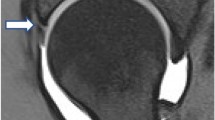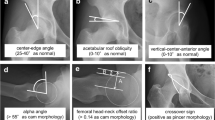Abstract
Background
Athroscopic treatment of acetabular labral tears is commonly performed for these patients. However, conservative treatment is generally considered to be the first choice of the treatment.
Purpose
We analyzed the clinical and radiological factors contributing to failure of conservative treatment of acetabular labral tears.
Methods
In this study, 75 patients (82 hips) with positive physical symptoms and radiologic evidence of labral tears were enrolled. All patients underwent conservative treatment for at least 6 weeks. Surgical treatment was carried out if the hip pain was not completely relieved. Clinical and radiological factors contributing to failure of conservative treatment were evaluated using univariate and multivariate analysis.
Results
There were 37 patients who improved with nonsurgical treatment, and the remaining patients (47 hips) underwent surgery (6 periarticular osteotomy, 11 partial debridement, and 28 labral refixation). Multivariate analysis indicated that the factor contributing to the response to conservative treatment was a tear of the ligamentum teres (p < 0.01). Those with tears of the ligamentum teres were 16.2 times (95 % CI, 5.39–49.1) more likely to undergo surgical treatment.
Conclusion
We identified a torn ligamentum teres as a factor contributing to the poor response to conservative treatment. Patients with a torn ligamentum teres develop subtle hip microinstability. Such microinstability may play a critical role in the pathogenesis of intra-articular lesions of the hip joint.


Similar content being viewed by others
References
Bumett RS, Della Rocca GJ, Prather H, Curry M, Maloney WJ, Clohisy JC (2006) Clinical presentation of patients with tears of the acetabular labrum. J Bone Joint Surg Am 88:1448–1457
Haene RA, Bradley M, Villar RN (2007) Hip dysplasia and the torn acetabular labrum: an inexact relationship. J Bone Joint Surg J Bone Joint Surg Br 89:1289–1292
Seldes RM, Tan V, Hunt J, Katz M, Winiarsky TR, Fitzerald RH Jr (2001) Anatomy, histologic features, and vascularity of the adult acetabular labrum. Clin Orthop Relat Res 382:232–240
Nho SJ, Magennis EM, Singh CK, Kelly BT (2011) Outcomes after the arthroscopic treatment of hemoroacetabular impingement in a mixed group of high-level athletes. Am J Sports Med 39:99–104
Philippon MJ, Weiss DR, Kuppersmith DV, Briggs KK, Hay CJ (2010) Arthroscopic labral repair and treatment of femoroacetabular impingement in professional hockey players. Am J Sport Med 38:99–104
Philippon MJ, Yen YM, Kuppersmith DV, Maxwell BS (2008) Early outcomes after hip arthroscopy for femoroacetabular impingement in the athletic adolescent patient. J Pediatr Orthop 28:705–710
Ellis HB, Briggs KK, Philippon MJ (2011) Innovation in hip arthroscopy: is hip arthritis preventable in the athlete? Br J Sports Med 45:253–258
Javed A, O'Donnel JM (2011) Arthroscopic femoral osteochondroplasty for cam femoroacetabular impingement in patients over 60 years of age. J Bone Joint Surg Br 93:326–331
Philippon MJ, Shenker M, Briggs KK, Kuppersmith D (2007) Femoroacetabular impingement in 45 professional athletes: associated pathologies and return to sport following arthroscopic decompression. Knee Surg Sports Traumatol Arthrosc 15:908–914
Kang C, Hwang DS, Cha SM (2009) Acetabular labral tears in patients with sports injury. Clini Orthop Surg 1:230–235
Byrd JWT, Jones KS (2011) Arthroscopic management of femoroacetabular impingement in athletes. Am J Sports Med 39:7S–13S
Malviya A, Stafford GH, Villar RN (2012) Impact of arthroscopy of the hip for femoroacetabular impingement on quality of life at a mean follow-up of 3.2 years. J Bone Joint Surg Br 94:466–470
Fabricant PD, Heyworth BE, Kelly BT (2012) Hip arthroscopy improves symptoms associated with FAI in selected adolescent athletes. Clin Orthop Relat Res 470:261–269
Philippon MJ, Briggs KK, Yen YM, Kuppersmith DA (2009) Outcomes following hip arthroscopy for femoroacetabular impingement with associated chondrolabral dysfunction. J Bone Joint Surg Br 91:16–23
Schilders E, Dimitrakopoulou A, Bismil Q, Marchant P, Cooke C (2011) Arthroscopic treatment of labral tears in femoroacetabular impingement. A comparative study of refixation and resection with a minimum two-year follow-up. J Bone Joint Surg Br 93:1027–1032
Byrd JWT, Jones KS (2009) Arthroscopic femoroplasty in the management of cam-type femoroacetabular impingement. Clin Orthop Relat Res 467:739–746
Philippon MJ, Maxwell BS, Johnston TL, Schenker ML, Briggs KK (2007) Clinical presentation of femoroacetabular impingement. Knee Surg Sports Traumatol Arthrosc 15:1041–1047
Philippon MJ, Stubbs AJ, Schenker ML, Maxwell BS, Gantz R, Leunig M (2007) Arthroscopic management of femoroacetabular impingement: osteoplasty management and literature review. Am J Sports Med 35:1571–1580
Notzli HP, Wyss TF, Stoecklin CH, Schmid MR, Triber K, Hodler J (2002) The contour of the femoral head-neck junction as a predictor for the risk of anterior impingement. J Bone Joint Surg Br 84:556–560
Johnstone TL, Shenker M, Briggs KK, Philippon MJ (2008) Relationship between offset angle alpha and hip chondral injury in femoroacetabular impingement. Arthroscopy 24:669–675
Philippon MJ, Shenker M (2006) A new method for acetabular rim trimming and labral repair. Clin Sports Med 25:293–297
Ganz R, Parvizi J, Beck M, Leunig M, Notzli H, Siebenrock KA (2003) Femoroacetabular impingement. A cause for osteoarthritis of the hip. CORR 417:112–120
Parvizi J, Brican O, Bender B, Mortazavi SMJ, Purtill J, Erickson J, Peters C (2009) Arthroscopy for labral tears in patients with developmental dysplasia of the hip: cautionary note. J Arthroplasty 24:110–111
Leunig M, Beaule PE, Ganz R (2009) The concept of femoroacetabular impingement. Clin Orthop Relat Res 467:616–622
Bardakos NV, Villar RN (2009) The ligamentum teres of the adult hip. J Bone Joint Surg Br 91:8–15
Chen HH, Li AF, Li KC, Wu JJ, Chen TS, Lee MC (1996) Adaptation of ligamentum teres in ischemic necrosis of human femoral head. Clin Orthop Relat Res 328:268–275
Hankenson KD, Turek JJ (1999) Procain anterior crusiate ligament fibroblasts are similar to cells derived from the ligamentum teres, another non-healing intra-articular ligament. Connect Tissue Res 40:13–21
Cerezl L, Kassarjian A, Canga A, Dobado MC, Montero FA, Llopis E, Rólon A, Pérez-Carro L (2010) Anatomy, biomechanics, imaging, and management of ligamentum teres injuries. Radiographics 30:1637–1651
Conflict of interest
The authors declare that they have no conflict of interest.
Author information
Authors and Affiliations
Corresponding author
Rights and permissions
About this article
Cite this article
Kaya, M., Kano, M., Sugi, A. et al. Factors contributing to the failure of conservative treatment for acetabular labrum tears. Eur Orthop Traumatol 5, 261–265 (2014). https://doi.org/10.1007/s12570-013-0238-7
Received:
Accepted:
Published:
Issue Date:
DOI: https://doi.org/10.1007/s12570-013-0238-7




